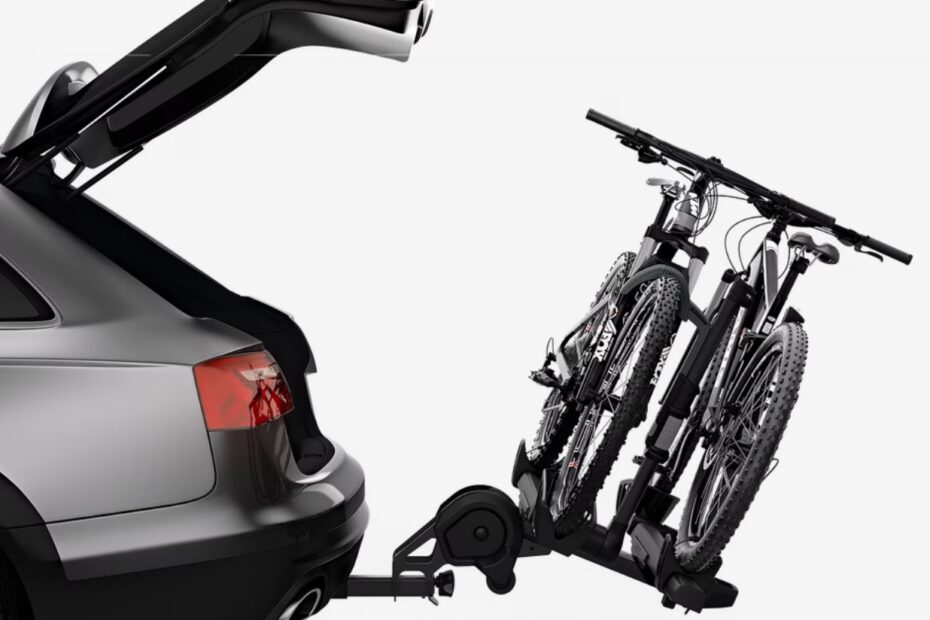Ebikes are heavy, what renders quite delicate choosing the right, safe bicycle carrier for your own car.
There are several types of bicycle carriers, but not all are adapted for ebike transport. In order to choose correctly, one should take into account how suitable they are for both his e-bike and car, while complying with traffic law requirements, which vary from one country to another.
General prescriptions and warnings to safely carry eBikes
- There should be a sufficient clearance between racks rails, otherwise electric bikes can damage each other.
- Rails should be deep and large enough for mountain bike tires.
- Carefully fix e-bikes to the bike carrier, by belt or clamp on the upper frame tube and avoid horizontal shaking. Fixations on the wheels prevent lateral movement. It’s better to take along spare belts, in case some belts get ripped.
- It’s normally better to take off ebike batteries and load them in the trunk or in the car. Just be careful to firmly secure them, if they are loose, they can hit something when you brake or turn, getting damaged or even catching fire. Also avoid leaving an electric bike battery inside a car parked in the hot sun, inside temperatures can exceed 60°C, causing the battery to catch fire. Try not to expose your battery to freezing or hot temperatures in your car for a long time, what can accelerate wear and discharge.
- Beware of your gas exhaust pipe. Hot gases and particles can damage tires when they are too close, soil your ebike and badly damage carbon rims.
Legal prescriptions for ebike carriers
Accordingly to traffic laws of most European countries, bike carriers should not exceed your car’s width by more than 30 cm (starting from your rear lights), nor your car length by more than 3 tenth, i.e. no more than 1.20 m for a 4 m long car. If we take into account that handlebars are about 80 cm long, it’s a problem for many cars. What’s more, if you hitch 60 kg overlapping the back of a small car by a meter, you surely worsen its handling and grip. You may not get fined; nevertheless, in case of accident, insurance companies will measure that, and you’ll have problems being reimbursed.
Bike racks normally carry small plates or inscriptions indicating the maximum total weight that they can carry, as well as for each rail. It’s not more than 50 kg on average, and between 18 and 30 kg per rail. Should you exceed that, insurance companies could refuse to refund you in case of incident. Just reckon that an ebike coming off a bike carrier on a motorway could kill people in a trailing car.
In many European countries, attaching a white and red reflective panel is mandatory for bike carriers.
- Thule van bike-carrier
- Thule trunk bike-rack
- Thule hitch bike-rack
Hitch bike carriers
Advantages of bike carriers for towing hook, or hook balls
- They just slightly worsen the car aerodynamics.
- Ebikes are less exposed to rain and high speed airstreams.
- They are quite low, making it easier to load up and unload your heavy e-bikes.
Disadvantages of hitch bike carriers
- Towing hooks are expensive, it takes on average €600 to have one installed on your car, and is not easy to find compatible ones.
- You can’t open your trunk, unless they can pivot down.
- Towing hooks have a maximum vertical load capacity of 80 kg; since the bike carrier alone can weigh more than 20 kg, that can be limiting.
- It can be hard to find a long enough parking place.

Bike carrier probably exceeding legal limits of 3/10 of car lenght, when handlebars are over its rear edge
Bike carriers to hang onto trunks, and van bike racks
Advantages
- No need to mount a hook ball.
- They are overall narrower than bike racks to mount on hook balls.
- Same advantages as hook ball racks.
Disadvantages
- They can carry only weights that are lighter than those enabled by hook ball racks. For instance, Thule, Europaen leader in this field, list no van rack among its eBike compatible carriers.
- Same disadvantages as hook ball racks.

Thule roof-bike-rack
Rooftop ebike carriers
Some are mounted on horizontal bars. Some use powerful vacuum caps, which can withstand both heat and cold weather, being quite resistant and easy to mount and take off.
Advantages of rooftop ebike carriers
- They are normally inexpensive, especially if you already have a rooftop luggage carrier, or if they have vacuum cups.
- They don’t elongate your car, so it’s not harder to find a long enough parking place.
Disadvantages of rooftop ebike carriers
- They worsen your car’s aerodynamics, thus increasing fuel consumption, or electricity consumption if it’s electric.
- Displays, drinks bottles and other accessories must be taken off your eBike, because speed generated air vortex can take them off.
- E-bikes are fully exposed to rain, and water can more easily penetrate into motors and connections, because of speed.
- Not all of them can carry ebikes exceeding 20 kg.
- Lifting a heavy ebike on the roof of your car is not easy.
- Many motorway gates, roads and garages just don’t have enough upper clearance, you risk costly damages to your car and E-bikes.
- Some of them require fixing through the fork front wheel holes, thus compelling you to load the wheel into your trunk.
- Most countries forbid driving faster than 120 km/h with such bicycle carriers, and exceeding that limit would be dangerous.
Photos courtesy of Thule



